ECE220 Assignment: Probing Children's Science Understanding(2018)
VerifiedAdded on 2023/06/13
|11
|2494
|57
Report
AI Summary
This report details an investigation into young children's understanding of the concepts of sinking and floating. It outlines the methodologies used to probe their existing knowledge, including experiments and targeted questioning techniques. The report identifies common misconceptions held by children regarding these scientific principles, such as the belief that size dictates whether an object sinks or floats. Furthermore, it discusses strategies for addressing these misconceptions and facilitating a deeper understanding of the concepts through hands-on activities and experiments. The assessment emphasizes the importance of understanding children's prior knowledge to tailor effective teaching methods. This document is available on Desklib, where students can find a variety of past papers and solved assignments.

Education 1
EDUCATION
By Name
Course
Instructor
Institution
Location
Date
EDUCATION
By Name
Course
Instructor
Institution
Location
Date
Paraphrase This Document
Need a fresh take? Get an instant paraphrase of this document with our AI Paraphraser
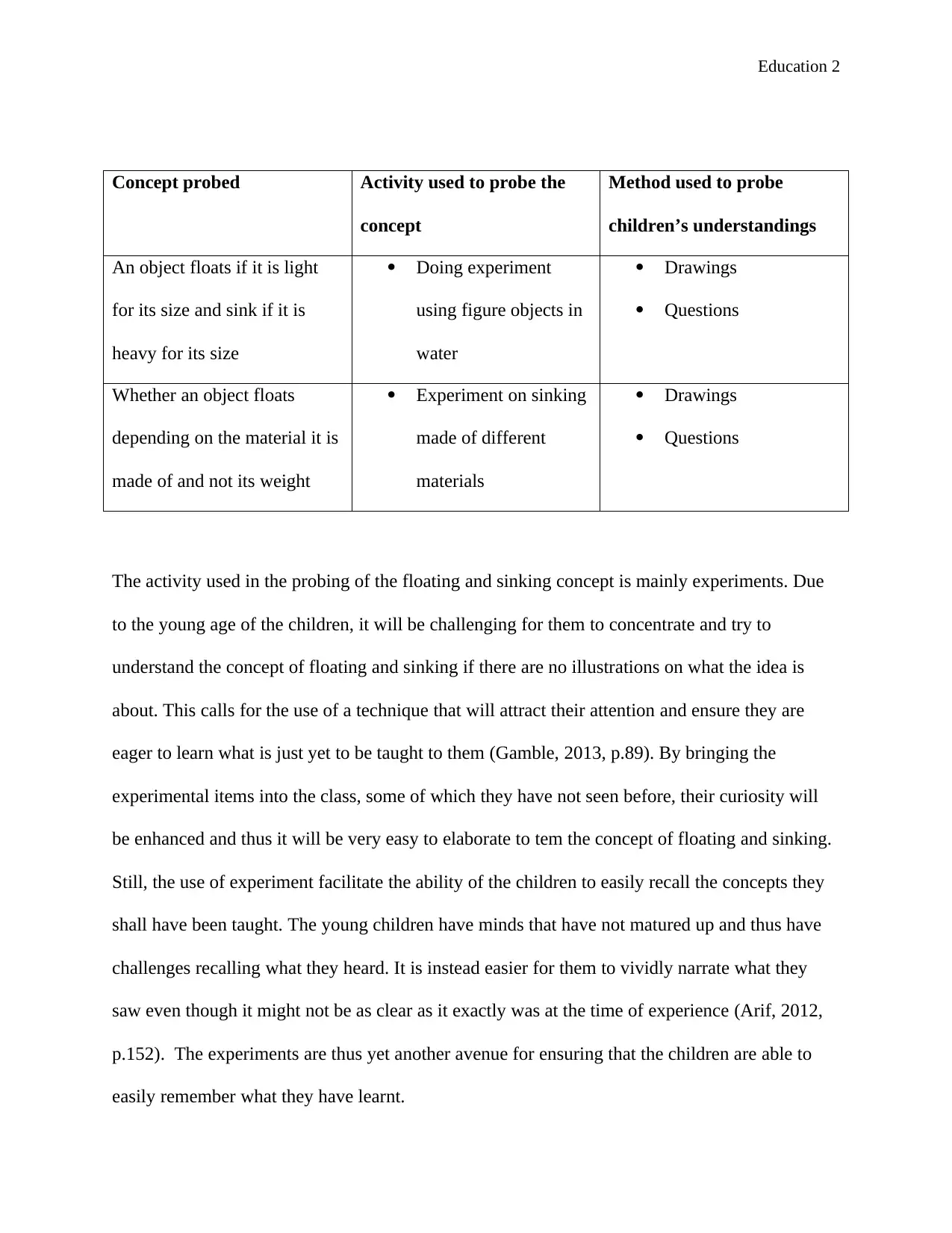
Education 2
Concept probed Activity used to probe the
concept
Method used to probe
children’s understandings
An object floats if it is light
for its size and sink if it is
heavy for its size
Doing experiment
using figure objects in
water
Drawings
Questions
Whether an object floats
depending on the material it is
made of and not its weight
Experiment on sinking
made of different
materials
Drawings
Questions
The activity used in the probing of the floating and sinking concept is mainly experiments. Due
to the young age of the children, it will be challenging for them to concentrate and try to
understand the concept of floating and sinking if there are no illustrations on what the idea is
about. This calls for the use of a technique that will attract their attention and ensure they are
eager to learn what is just yet to be taught to them (Gamble, 2013, p.89). By bringing the
experimental items into the class, some of which they have not seen before, their curiosity will
be enhanced and thus it will be very easy to elaborate to tem the concept of floating and sinking.
Still, the use of experiment facilitate the ability of the children to easily recall the concepts they
shall have been taught. The young children have minds that have not matured up and thus have
challenges recalling what they heard. It is instead easier for them to vividly narrate what they
saw even though it might not be as clear as it exactly was at the time of experience (Arif, 2012,
p.152). The experiments are thus yet another avenue for ensuring that the children are able to
easily remember what they have learnt.
Concept probed Activity used to probe the
concept
Method used to probe
children’s understandings
An object floats if it is light
for its size and sink if it is
heavy for its size
Doing experiment
using figure objects in
water
Drawings
Questions
Whether an object floats
depending on the material it is
made of and not its weight
Experiment on sinking
made of different
materials
Drawings
Questions
The activity used in the probing of the floating and sinking concept is mainly experiments. Due
to the young age of the children, it will be challenging for them to concentrate and try to
understand the concept of floating and sinking if there are no illustrations on what the idea is
about. This calls for the use of a technique that will attract their attention and ensure they are
eager to learn what is just yet to be taught to them (Gamble, 2013, p.89). By bringing the
experimental items into the class, some of which they have not seen before, their curiosity will
be enhanced and thus it will be very easy to elaborate to tem the concept of floating and sinking.
Still, the use of experiment facilitate the ability of the children to easily recall the concepts they
shall have been taught. The young children have minds that have not matured up and thus have
challenges recalling what they heard. It is instead easier for them to vividly narrate what they
saw even though it might not be as clear as it exactly was at the time of experience (Arif, 2012,
p.152). The experiments are thus yet another avenue for ensuring that the children are able to
easily remember what they have learnt.
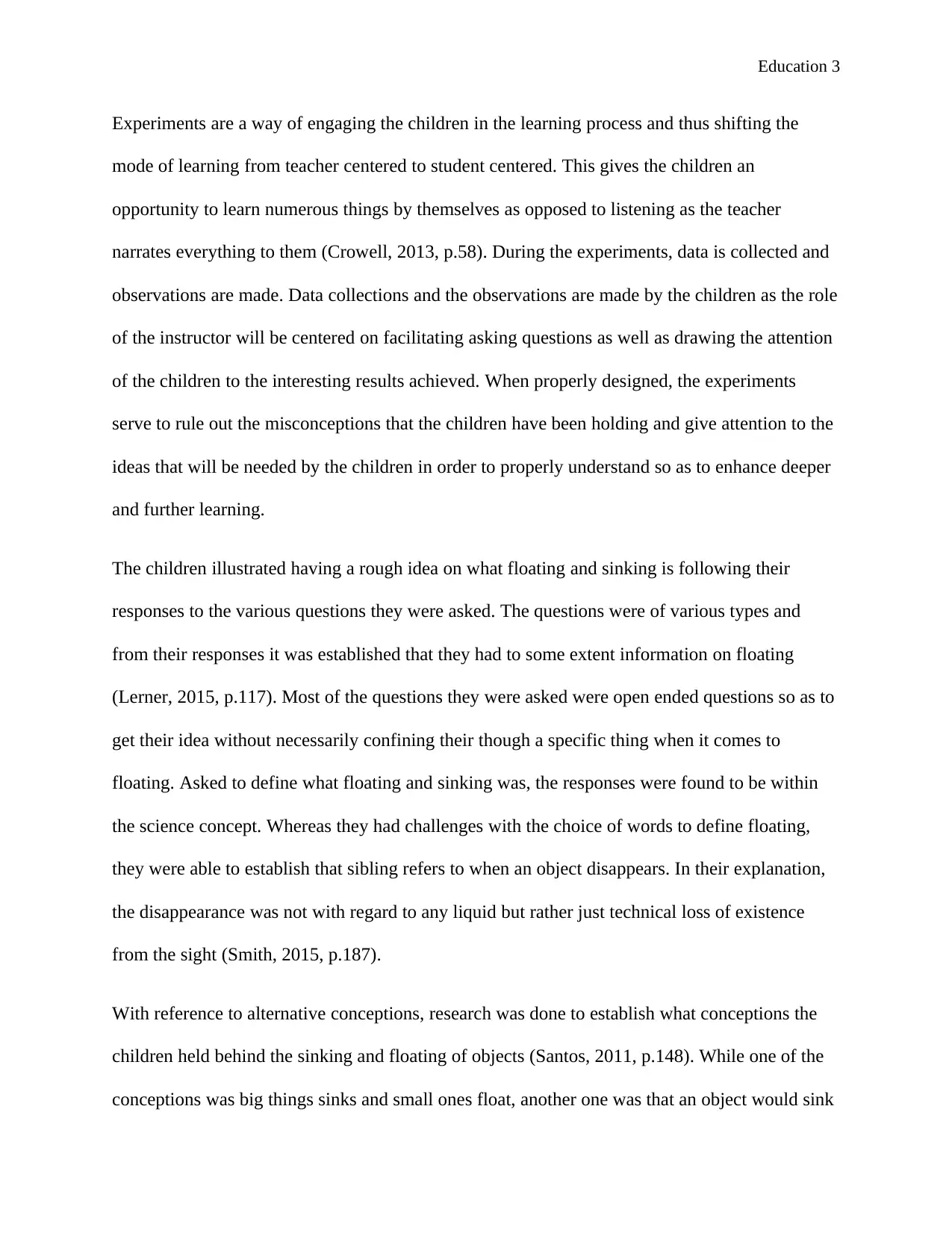
Education 3
Experiments are a way of engaging the children in the learning process and thus shifting the
mode of learning from teacher centered to student centered. This gives the children an
opportunity to learn numerous things by themselves as opposed to listening as the teacher
narrates everything to them (Crowell, 2013, p.58). During the experiments, data is collected and
observations are made. Data collections and the observations are made by the children as the role
of the instructor will be centered on facilitating asking questions as well as drawing the attention
of the children to the interesting results achieved. When properly designed, the experiments
serve to rule out the misconceptions that the children have been holding and give attention to the
ideas that will be needed by the children in order to properly understand so as to enhance deeper
and further learning.
The children illustrated having a rough idea on what floating and sinking is following their
responses to the various questions they were asked. The questions were of various types and
from their responses it was established that they had to some extent information on floating
(Lerner, 2015, p.117). Most of the questions they were asked were open ended questions so as to
get their idea without necessarily confining their though a specific thing when it comes to
floating. Asked to define what floating and sinking was, the responses were found to be within
the science concept. Whereas they had challenges with the choice of words to define floating,
they were able to establish that sibling refers to when an object disappears. In their explanation,
the disappearance was not with regard to any liquid but rather just technical loss of existence
from the sight (Smith, 2015, p.187).
With reference to alternative conceptions, research was done to establish what conceptions the
children held behind the sinking and floating of objects (Santos, 2011, p.148). While one of the
conceptions was big things sinks and small ones float, another one was that an object would sink
Experiments are a way of engaging the children in the learning process and thus shifting the
mode of learning from teacher centered to student centered. This gives the children an
opportunity to learn numerous things by themselves as opposed to listening as the teacher
narrates everything to them (Crowell, 2013, p.58). During the experiments, data is collected and
observations are made. Data collections and the observations are made by the children as the role
of the instructor will be centered on facilitating asking questions as well as drawing the attention
of the children to the interesting results achieved. When properly designed, the experiments
serve to rule out the misconceptions that the children have been holding and give attention to the
ideas that will be needed by the children in order to properly understand so as to enhance deeper
and further learning.
The children illustrated having a rough idea on what floating and sinking is following their
responses to the various questions they were asked. The questions were of various types and
from their responses it was established that they had to some extent information on floating
(Lerner, 2015, p.117). Most of the questions they were asked were open ended questions so as to
get their idea without necessarily confining their though a specific thing when it comes to
floating. Asked to define what floating and sinking was, the responses were found to be within
the science concept. Whereas they had challenges with the choice of words to define floating,
they were able to establish that sibling refers to when an object disappears. In their explanation,
the disappearance was not with regard to any liquid but rather just technical loss of existence
from the sight (Smith, 2015, p.187).
With reference to alternative conceptions, research was done to establish what conceptions the
children held behind the sinking and floating of objects (Santos, 2011, p.148). While one of the
conceptions was big things sinks and small ones float, another one was that an object would sink
⊘ This is a preview!⊘
Do you want full access?
Subscribe today to unlock all pages.

Trusted by 1+ million students worldwide
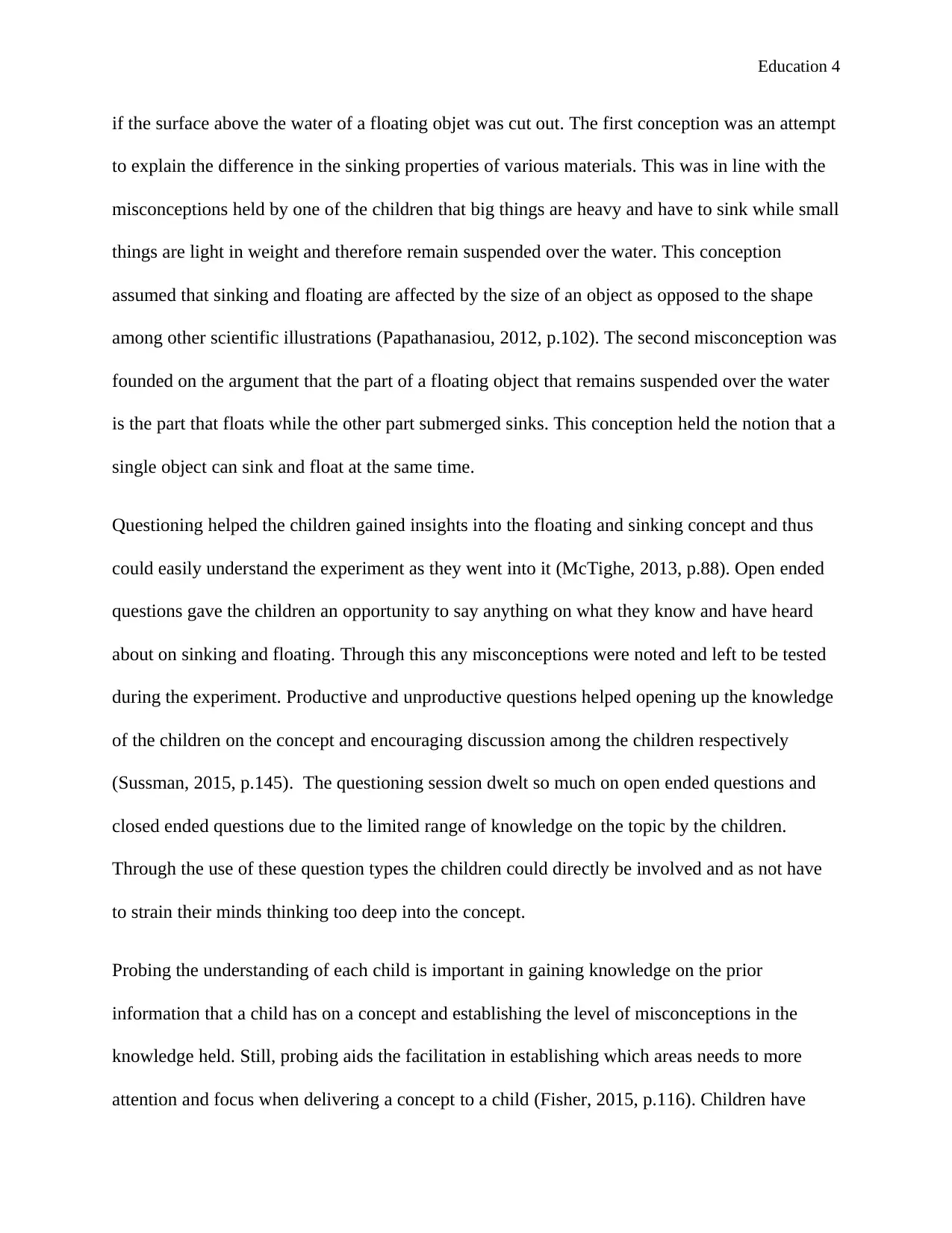
Education 4
if the surface above the water of a floating objet was cut out. The first conception was an attempt
to explain the difference in the sinking properties of various materials. This was in line with the
misconceptions held by one of the children that big things are heavy and have to sink while small
things are light in weight and therefore remain suspended over the water. This conception
assumed that sinking and floating are affected by the size of an object as opposed to the shape
among other scientific illustrations (Papathanasiou, 2012, p.102). The second misconception was
founded on the argument that the part of a floating object that remains suspended over the water
is the part that floats while the other part submerged sinks. This conception held the notion that a
single object can sink and float at the same time.
Questioning helped the children gained insights into the floating and sinking concept and thus
could easily understand the experiment as they went into it (McTighe, 2013, p.88). Open ended
questions gave the children an opportunity to say anything on what they know and have heard
about on sinking and floating. Through this any misconceptions were noted and left to be tested
during the experiment. Productive and unproductive questions helped opening up the knowledge
of the children on the concept and encouraging discussion among the children respectively
(Sussman, 2015, p.145). The questioning session dwelt so much on open ended questions and
closed ended questions due to the limited range of knowledge on the topic by the children.
Through the use of these question types the children could directly be involved and as not have
to strain their minds thinking too deep into the concept.
Probing the understanding of each child is important in gaining knowledge on the prior
information that a child has on a concept and establishing the level of misconceptions in the
knowledge held. Still, probing aids the facilitation in establishing which areas needs to more
attention and focus when delivering a concept to a child (Fisher, 2015, p.116). Children have
if the surface above the water of a floating objet was cut out. The first conception was an attempt
to explain the difference in the sinking properties of various materials. This was in line with the
misconceptions held by one of the children that big things are heavy and have to sink while small
things are light in weight and therefore remain suspended over the water. This conception
assumed that sinking and floating are affected by the size of an object as opposed to the shape
among other scientific illustrations (Papathanasiou, 2012, p.102). The second misconception was
founded on the argument that the part of a floating object that remains suspended over the water
is the part that floats while the other part submerged sinks. This conception held the notion that a
single object can sink and float at the same time.
Questioning helped the children gained insights into the floating and sinking concept and thus
could easily understand the experiment as they went into it (McTighe, 2013, p.88). Open ended
questions gave the children an opportunity to say anything on what they know and have heard
about on sinking and floating. Through this any misconceptions were noted and left to be tested
during the experiment. Productive and unproductive questions helped opening up the knowledge
of the children on the concept and encouraging discussion among the children respectively
(Sussman, 2015, p.145). The questioning session dwelt so much on open ended questions and
closed ended questions due to the limited range of knowledge on the topic by the children.
Through the use of these question types the children could directly be involved and as not have
to strain their minds thinking too deep into the concept.
Probing the understanding of each child is important in gaining knowledge on the prior
information that a child has on a concept and establishing the level of misconceptions in the
knowledge held. Still, probing aids the facilitation in establishing which areas needs to more
attention and focus when delivering a concept to a child (Fisher, 2015, p.116). Children have
Paraphrase This Document
Need a fresh take? Get an instant paraphrase of this document with our AI Paraphraser
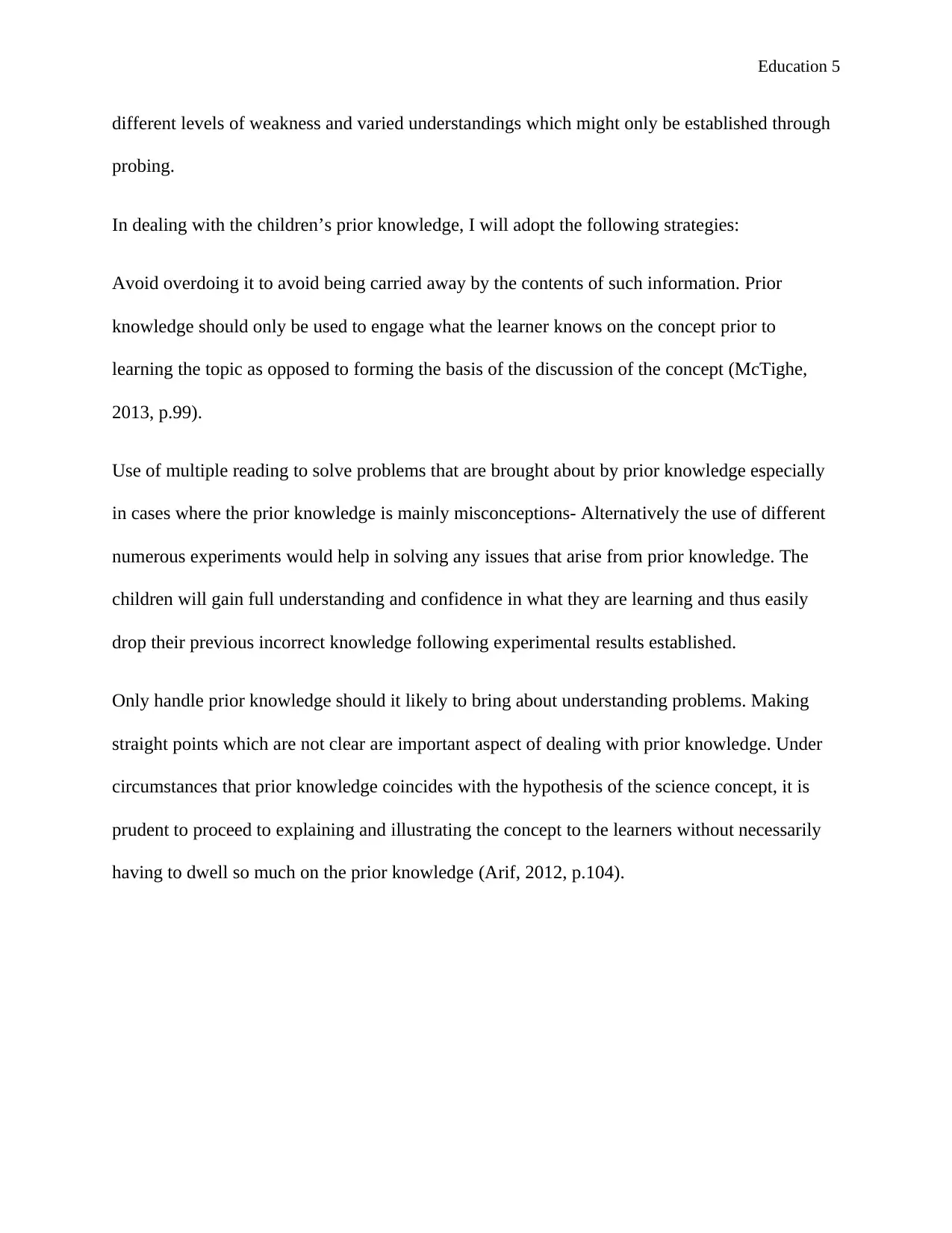
Education 5
different levels of weakness and varied understandings which might only be established through
probing.
In dealing with the children’s prior knowledge, I will adopt the following strategies:
Avoid overdoing it to avoid being carried away by the contents of such information. Prior
knowledge should only be used to engage what the learner knows on the concept prior to
learning the topic as opposed to forming the basis of the discussion of the concept (McTighe,
2013, p.99).
Use of multiple reading to solve problems that are brought about by prior knowledge especially
in cases where the prior knowledge is mainly misconceptions- Alternatively the use of different
numerous experiments would help in solving any issues that arise from prior knowledge. The
children will gain full understanding and confidence in what they are learning and thus easily
drop their previous incorrect knowledge following experimental results established.
Only handle prior knowledge should it likely to bring about understanding problems. Making
straight points which are not clear are important aspect of dealing with prior knowledge. Under
circumstances that prior knowledge coincides with the hypothesis of the science concept, it is
prudent to proceed to explaining and illustrating the concept to the learners without necessarily
having to dwell so much on the prior knowledge (Arif, 2012, p.104).
different levels of weakness and varied understandings which might only be established through
probing.
In dealing with the children’s prior knowledge, I will adopt the following strategies:
Avoid overdoing it to avoid being carried away by the contents of such information. Prior
knowledge should only be used to engage what the learner knows on the concept prior to
learning the topic as opposed to forming the basis of the discussion of the concept (McTighe,
2013, p.99).
Use of multiple reading to solve problems that are brought about by prior knowledge especially
in cases where the prior knowledge is mainly misconceptions- Alternatively the use of different
numerous experiments would help in solving any issues that arise from prior knowledge. The
children will gain full understanding and confidence in what they are learning and thus easily
drop their previous incorrect knowledge following experimental results established.
Only handle prior knowledge should it likely to bring about understanding problems. Making
straight points which are not clear are important aspect of dealing with prior knowledge. Under
circumstances that prior knowledge coincides with the hypothesis of the science concept, it is
prudent to proceed to explaining and illustrating the concept to the learners without necessarily
having to dwell so much on the prior knowledge (Arif, 2012, p.104).
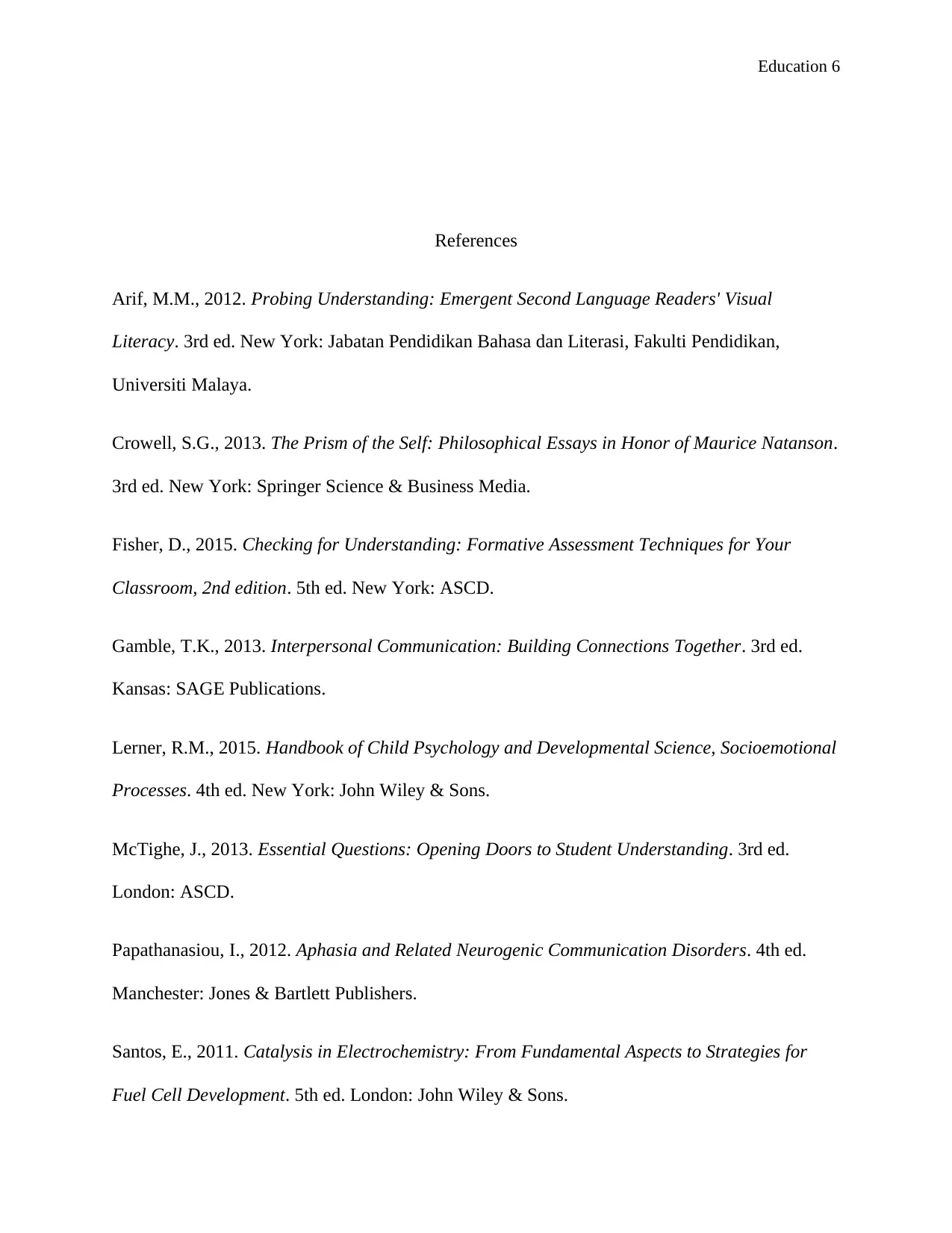
Education 6
References
Arif, M.M., 2012. Probing Understanding: Emergent Second Language Readers' Visual
Literacy. 3rd ed. New York: Jabatan Pendidikan Bahasa dan Literasi, Fakulti Pendidikan,
Universiti Malaya.
Crowell, S.G., 2013. The Prism of the Self: Philosophical Essays in Honor of Maurice Natanson.
3rd ed. New York: Springer Science & Business Media.
Fisher, D., 2015. Checking for Understanding: Formative Assessment Techniques for Your
Classroom, 2nd edition. 5th ed. New York: ASCD.
Gamble, T.K., 2013. Interpersonal Communication: Building Connections Together. 3rd ed.
Kansas: SAGE Publications.
Lerner, R.M., 2015. Handbook of Child Psychology and Developmental Science, Socioemotional
Processes. 4th ed. New York: John Wiley & Sons.
McTighe, J., 2013. Essential Questions: Opening Doors to Student Understanding. 3rd ed.
London: ASCD.
Papathanasiou, I., 2012. Aphasia and Related Neurogenic Communication Disorders. 4th ed.
Manchester: Jones & Bartlett Publishers.
Santos, E., 2011. Catalysis in Electrochemistry: From Fundamental Aspects to Strategies for
Fuel Cell Development. 5th ed. London: John Wiley & Sons.
References
Arif, M.M., 2012. Probing Understanding: Emergent Second Language Readers' Visual
Literacy. 3rd ed. New York: Jabatan Pendidikan Bahasa dan Literasi, Fakulti Pendidikan,
Universiti Malaya.
Crowell, S.G., 2013. The Prism of the Self: Philosophical Essays in Honor of Maurice Natanson.
3rd ed. New York: Springer Science & Business Media.
Fisher, D., 2015. Checking for Understanding: Formative Assessment Techniques for Your
Classroom, 2nd edition. 5th ed. New York: ASCD.
Gamble, T.K., 2013. Interpersonal Communication: Building Connections Together. 3rd ed.
Kansas: SAGE Publications.
Lerner, R.M., 2015. Handbook of Child Psychology and Developmental Science, Socioemotional
Processes. 4th ed. New York: John Wiley & Sons.
McTighe, J., 2013. Essential Questions: Opening Doors to Student Understanding. 3rd ed.
London: ASCD.
Papathanasiou, I., 2012. Aphasia and Related Neurogenic Communication Disorders. 4th ed.
Manchester: Jones & Bartlett Publishers.
Santos, E., 2011. Catalysis in Electrochemistry: From Fundamental Aspects to Strategies for
Fuel Cell Development. 5th ed. London: John Wiley & Sons.
⊘ This is a preview!⊘
Do you want full access?
Subscribe today to unlock all pages.

Trusted by 1+ million students worldwide

Education 7
Smith, D.G., 2015. Strata and Time: Probing the Gaps in Our Understanding. 4th ed. London:
Geological Society of London.
Sussman, E.S., 2015. Probing auditory scene analysis. 5th ed. Beijing: Frontiers E-books.
Smith, D.G., 2015. Strata and Time: Probing the Gaps in Our Understanding. 4th ed. London:
Geological Society of London.
Sussman, E.S., 2015. Probing auditory scene analysis. 5th ed. Beijing: Frontiers E-books.
Paraphrase This Document
Need a fresh take? Get an instant paraphrase of this document with our AI Paraphraser
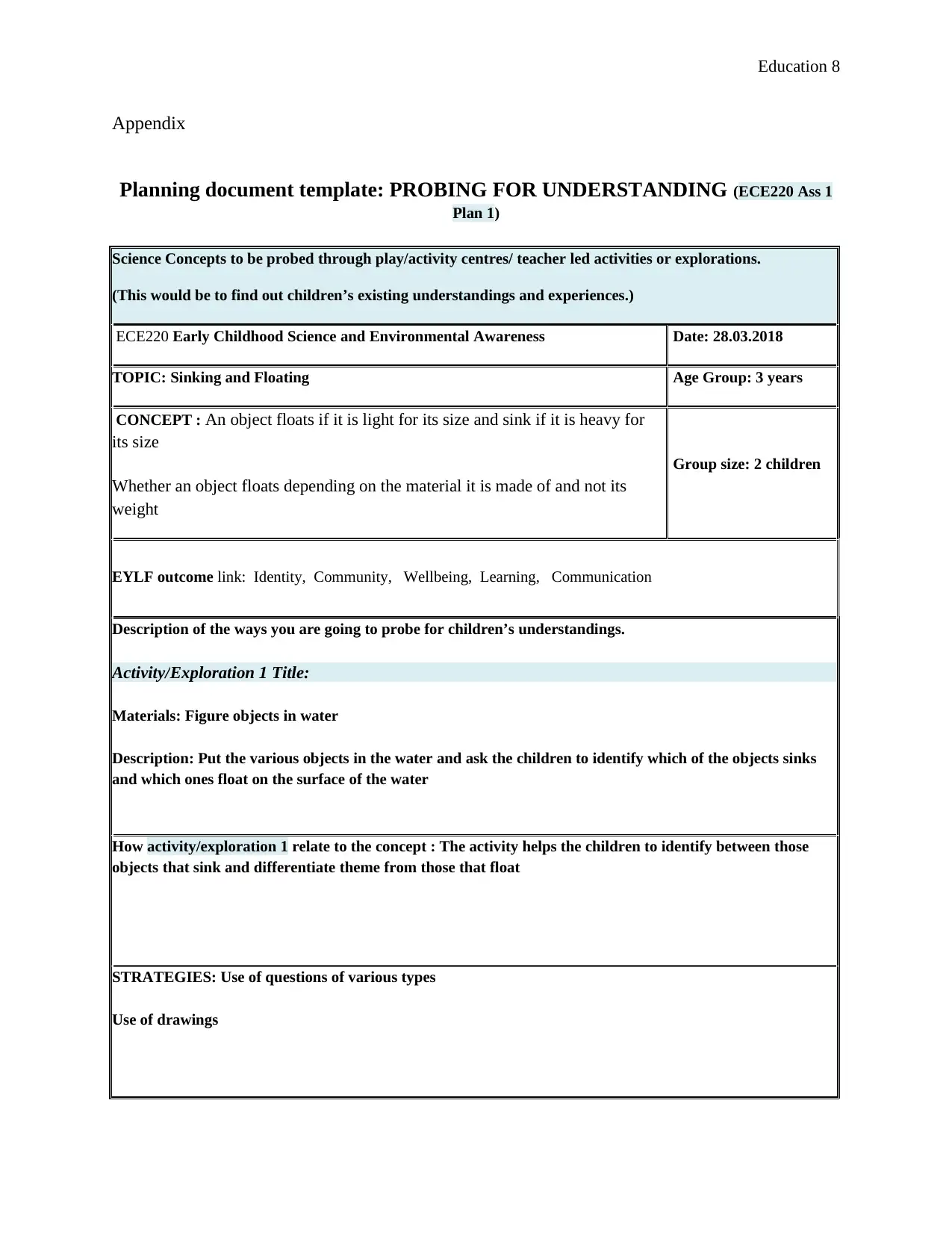
Education 8
Appendix
Planning document template: PROBING FOR UNDERSTANDING (ECE220 Ass 1
Plan 1)
Science Concepts to be probed through play/activity centres/ teacher led activities or explorations.
(This would be to find out children’s existing understandings and experiences.)
ECE220 Early Childhood Science and Environmental Awareness Date: 28.03.2018
TOPIC: Sinking and Floating Age Group: 3 years
CONCEPT : An object floats if it is light for its size and sink if it is heavy for
its size
Whether an object floats depending on the material it is made of and not its
weight
Group size: 2 children
EYLF outcome link: Identity, Community, Wellbeing, Learning, Communication
Description of the ways you are going to probe for children’s understandings.
Activity/Exploration 1 Title:
Materials: Figure objects in water
Description: Put the various objects in the water and ask the children to identify which of the objects sinks
and which ones float on the surface of the water
How activity/exploration 1 relate to the concept : The activity helps the children to identify between those
objects that sink and differentiate theme from those that float
STRATEGIES: Use of questions of various types
Use of drawings
Appendix
Planning document template: PROBING FOR UNDERSTANDING (ECE220 Ass 1
Plan 1)
Science Concepts to be probed through play/activity centres/ teacher led activities or explorations.
(This would be to find out children’s existing understandings and experiences.)
ECE220 Early Childhood Science and Environmental Awareness Date: 28.03.2018
TOPIC: Sinking and Floating Age Group: 3 years
CONCEPT : An object floats if it is light for its size and sink if it is heavy for
its size
Whether an object floats depending on the material it is made of and not its
weight
Group size: 2 children
EYLF outcome link: Identity, Community, Wellbeing, Learning, Communication
Description of the ways you are going to probe for children’s understandings.
Activity/Exploration 1 Title:
Materials: Figure objects in water
Description: Put the various objects in the water and ask the children to identify which of the objects sinks
and which ones float on the surface of the water
How activity/exploration 1 relate to the concept : The activity helps the children to identify between those
objects that sink and differentiate theme from those that float
STRATEGIES: Use of questions of various types
Use of drawings
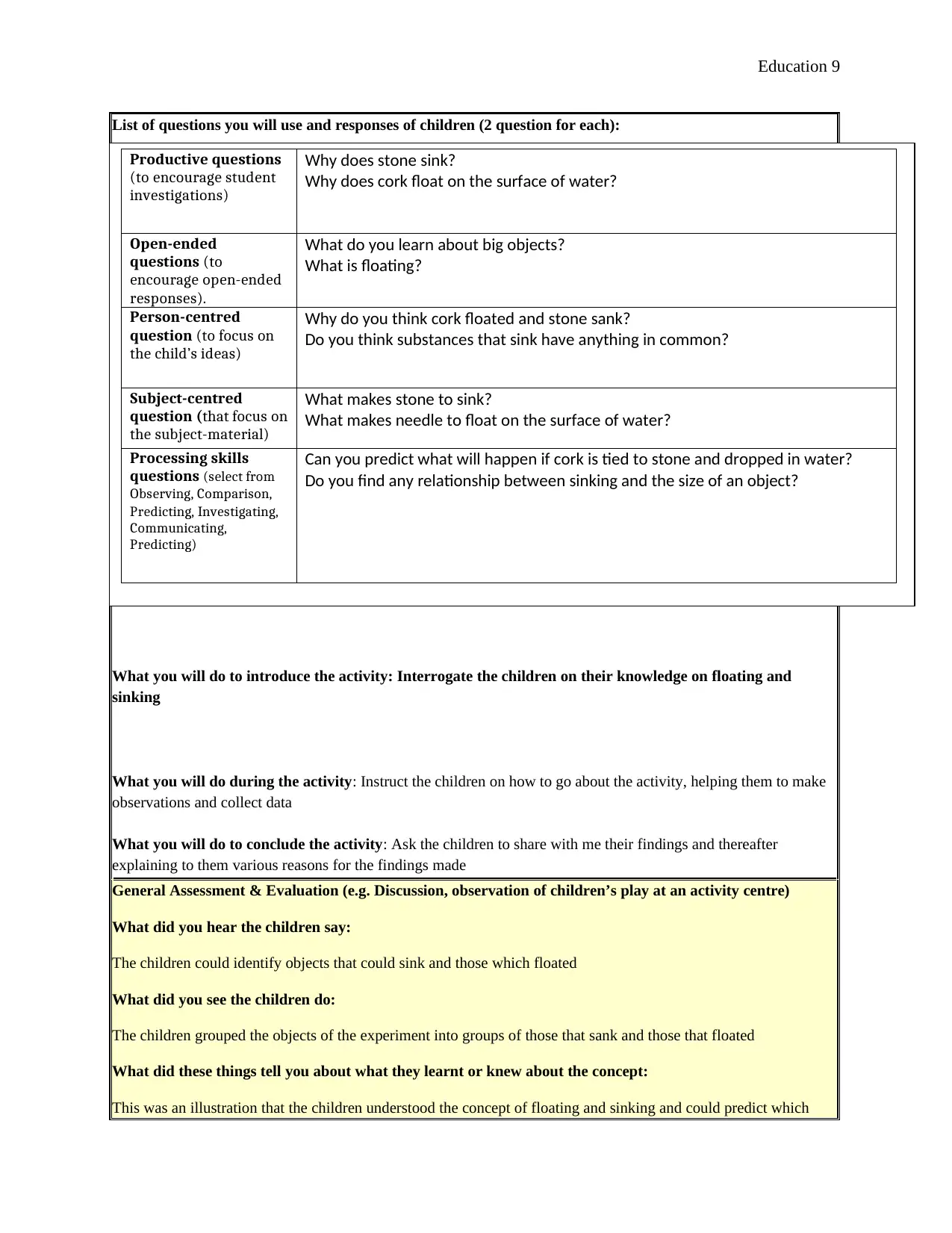
Education 9
List of questions you will use and responses of children (2 question for each):
What you will do to introduce the activity: Interrogate the children on their knowledge on floating and
sinking
What you will do during the activity: Instruct the children on how to go about the activity, helping them to make
observations and collect data
What you will do to conclude the activity: Ask the children to share with me their findings and thereafter
explaining to them various reasons for the findings made
General Assessment & Evaluation (e.g. Discussion, observation of children’s play at an activity centre)
What did you hear the children say:
The children could identify objects that could sink and those which floated
What did you see the children do:
The children grouped the objects of the experiment into groups of those that sank and those that floated
What did these things tell you about what they learnt or knew about the concept:
This was an illustration that the children understood the concept of floating and sinking and could predict which
Productive questions
(to encourage student
investigations)
Why does stone sink?
Why does cork float on the surface of water?
Open-ended
questions (to
encourage open-ended
responses).
What do you learn about big objects?
What is floating?
Person-centred
question (to focus on
the child’s ideas)
Why do you think cork floated and stone sank?
Do you think substances that sink have anything in common?
Subject-centred
question (that focus on
the subject-material)
What makes stone to sink?
What makes needle to float on the surface of water?
Processing skills
questions (select from
Observing, Comparison,
Predicting, Investigating,
Communicating,
Predicting)
Can you predict what will happen if cork is tied to stone and dropped in water?
Do you find any relationship between sinking and the size of an object?
List of questions you will use and responses of children (2 question for each):
What you will do to introduce the activity: Interrogate the children on their knowledge on floating and
sinking
What you will do during the activity: Instruct the children on how to go about the activity, helping them to make
observations and collect data
What you will do to conclude the activity: Ask the children to share with me their findings and thereafter
explaining to them various reasons for the findings made
General Assessment & Evaluation (e.g. Discussion, observation of children’s play at an activity centre)
What did you hear the children say:
The children could identify objects that could sink and those which floated
What did you see the children do:
The children grouped the objects of the experiment into groups of those that sank and those that floated
What did these things tell you about what they learnt or knew about the concept:
This was an illustration that the children understood the concept of floating and sinking and could predict which
Productive questions
(to encourage student
investigations)
Why does stone sink?
Why does cork float on the surface of water?
Open-ended
questions (to
encourage open-ended
responses).
What do you learn about big objects?
What is floating?
Person-centred
question (to focus on
the child’s ideas)
Why do you think cork floated and stone sank?
Do you think substances that sink have anything in common?
Subject-centred
question (that focus on
the subject-material)
What makes stone to sink?
What makes needle to float on the surface of water?
Processing skills
questions (select from
Observing, Comparison,
Predicting, Investigating,
Communicating,
Predicting)
Can you predict what will happen if cork is tied to stone and dropped in water?
Do you find any relationship between sinking and the size of an object?
⊘ This is a preview!⊘
Do you want full access?
Subscribe today to unlock all pages.

Trusted by 1+ million students worldwide
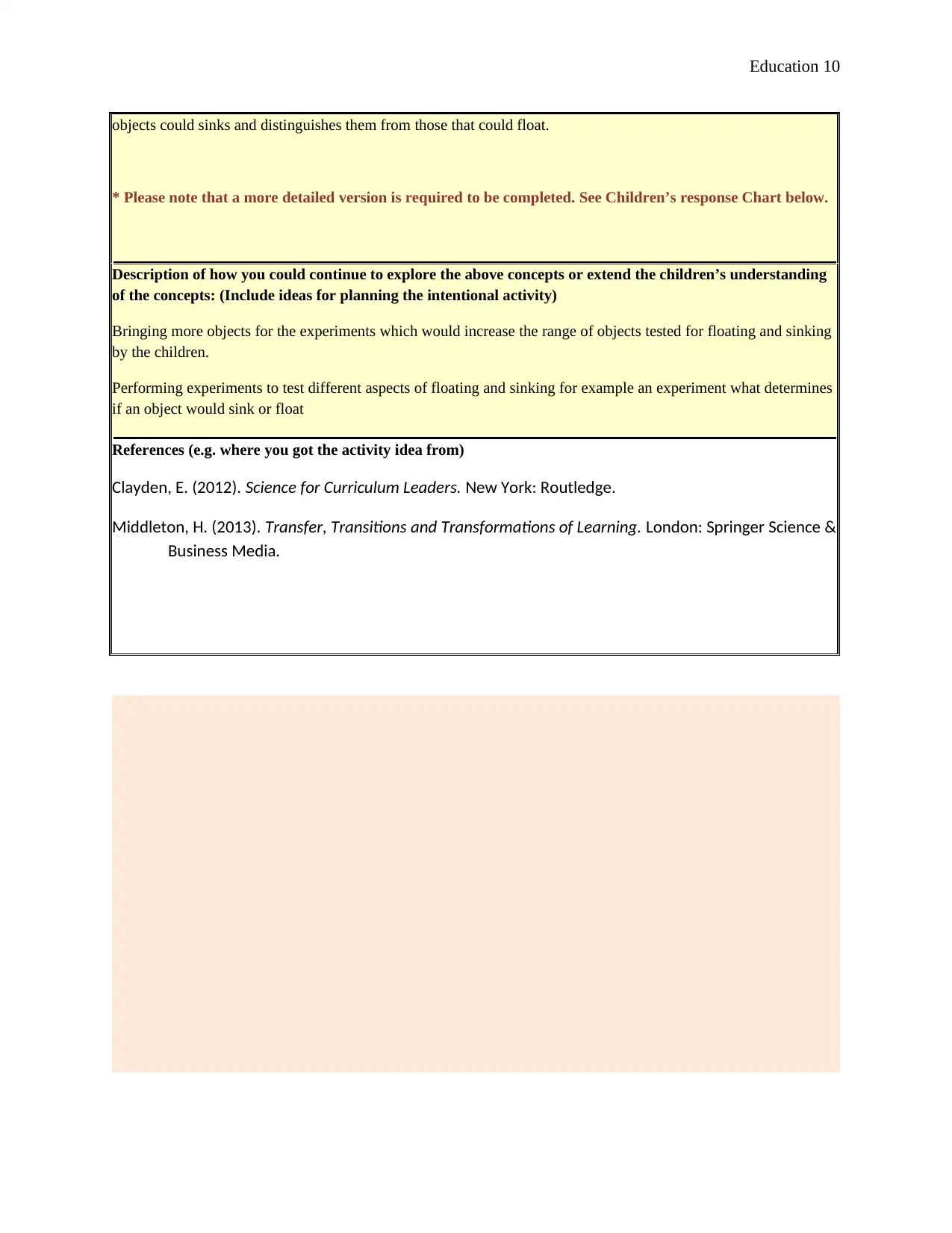
Education 10
objects could sinks and distinguishes them from those that could float.
* Please note that a more detailed version is required to be completed. See Children’s response Chart below.
Description of how you could continue to explore the above concepts or extend the children’s understanding
of the concepts: (Include ideas for planning the intentional activity)
Bringing more objects for the experiments which would increase the range of objects tested for floating and sinking
by the children.
Performing experiments to test different aspects of floating and sinking for example an experiment what determines
if an object would sink or float
References (e.g. where you got the activity idea from)
Clayden, E. (2012). Science for Curriculum Leaders. New York: Routledge.
Middleton, H. (2013). Transfer, Transitions and Transformations of Learning. London: Springer Science &
Business Media.
objects could sinks and distinguishes them from those that could float.
* Please note that a more detailed version is required to be completed. See Children’s response Chart below.
Description of how you could continue to explore the above concepts or extend the children’s understanding
of the concepts: (Include ideas for planning the intentional activity)
Bringing more objects for the experiments which would increase the range of objects tested for floating and sinking
by the children.
Performing experiments to test different aspects of floating and sinking for example an experiment what determines
if an object would sink or float
References (e.g. where you got the activity idea from)
Clayden, E. (2012). Science for Curriculum Leaders. New York: Routledge.
Middleton, H. (2013). Transfer, Transitions and Transformations of Learning. London: Springer Science &
Business Media.
Paraphrase This Document
Need a fresh take? Get an instant paraphrase of this document with our AI Paraphraser

Education 11
Appendix
CHILDREN’S RESPONSE CHART
Please remember to add below the other questions you planned to ask and any that you asked
spontaneously on the day- ensure that the questions matches the type of question (See the Categorising
questions sheet)
Productive
questions (to
encourage student
investigations)
Why does stone sink?
Why does cork float on the surface of water?
Open-ended
questions (to
encourage open-
ended responses).
What do you learn about big objects?
What is floating?
Person-centred
question (to focus on
the child’s ideas)
Why do you think cork floated and stone sank?
Do you think substances that sink have anything in common?
Subject-centred
question (that focus
on the subject-
material)
What makes stone to sink?
What makes needle to float on the surface of water?
Processing skills
questions (select from
Observing, Comparison,
Predicting,
Investigating,
Communicating,
Predicting)
Can you predict what will happen if cork is tied to stone and dropped in
water?
Do you find any relationship between sinking and the size of an object?
Appendix
CHILDREN’S RESPONSE CHART
Please remember to add below the other questions you planned to ask and any that you asked
spontaneously on the day- ensure that the questions matches the type of question (See the Categorising
questions sheet)
Productive
questions (to
encourage student
investigations)
Why does stone sink?
Why does cork float on the surface of water?
Open-ended
questions (to
encourage open-
ended responses).
What do you learn about big objects?
What is floating?
Person-centred
question (to focus on
the child’s ideas)
Why do you think cork floated and stone sank?
Do you think substances that sink have anything in common?
Subject-centred
question (that focus
on the subject-
material)
What makes stone to sink?
What makes needle to float on the surface of water?
Processing skills
questions (select from
Observing, Comparison,
Predicting,
Investigating,
Communicating,
Predicting)
Can you predict what will happen if cork is tied to stone and dropped in
water?
Do you find any relationship between sinking and the size of an object?
1 out of 11
Related Documents
Your All-in-One AI-Powered Toolkit for Academic Success.
+13062052269
info@desklib.com
Available 24*7 on WhatsApp / Email
![[object Object]](/_next/static/media/star-bottom.7253800d.svg)
Unlock your academic potential
Copyright © 2020–2025 A2Z Services. All Rights Reserved. Developed and managed by ZUCOL.




